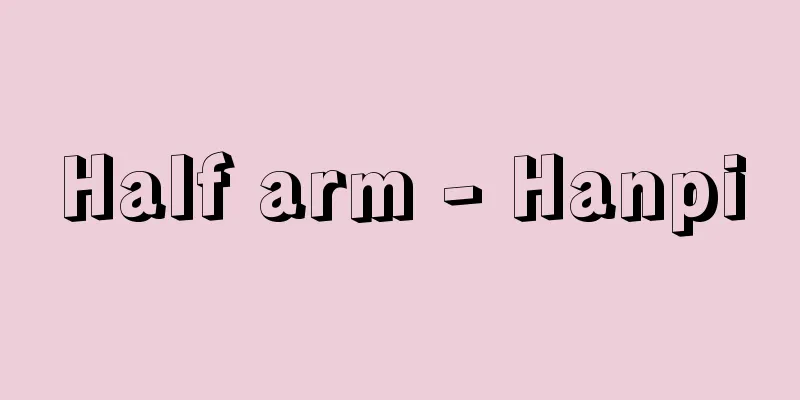Half arm - Hanpi

|
A type of clothing for the aristocracy. It is an inner garment for men's morning wear, worn under a robe or sliding screen. From the Nara period to the early Heian period, the hanbi had narrow sleeves, which is where the name comes from. The waist is narrow and the length of the body is short, with the fabric laid horizontally at the hem, and pleated brocade is sewn to the sides and three places on the back. From the mid-Heian period onwards, as morning wear became more Japanese and longer, and came to be called sokutai, the hanbi also changed to a straight-cut style and sleeveless style like other clothing. The waist is tied with a small string made of the same fabric as the body, and the remaining part is set aside, with a single width of fabric folded in half and hung over the small string, which was called wasureo. Fabrics used from the Nara period through to the early Heian period were ashiginu, plain silk, and aya, while from the mid-Heian period onwards, in winter those of the fifth rank or higher wore black twill and small hollyhock patterns, those of the sixth rank or lower wore plain silk or plain twill, in summer those of the fifth rank or higher wore black koku and triple sash patterns, and for brocade those of the fifth rank or higher in both summer and winter, black ura was used. The half-sleeves of bugaku costumes are often gorgeous, and those kept in the Shosoin Repository have patterns made with rokechi, koukechi, and kyokechi, or use nishiki, while those from the Middle Ages onwards use embroidery, tie-dyeing, and brocade. [Takada Yamato] [Reference item] |©Minoru Sugai Half arm Source: Shogakukan Encyclopedia Nipponica About Encyclopedia Nipponica Information | Legend |
|
貴族階級の衣服の一種。男子朝服の内衣で、袍(ほう)や襖(あお)の下に着用する。奈良時代から平安時代初期にかけての半臂は、袖(そで)幅が狭く、それが名称の由来である。腰部を細くして丈が短い身頃(みごろ)の裾(すそ)に生地(きじ)を横向きにして、両側と後ろの三か所に、襞(ひだ)をとった襴(らん)を縫い付けている。平安時代中期以降、朝服が和様化し、長大化して束帯といわれるようになると、半臂も他の衣服と同様に直線裁ち式で、袖をつけない形に変化した。身頃と同じ生地で仕立てた小紐(こひも)で腰を締め、その結び余りの部分のみを別にし、一幅(ひとの)の生地を中折れに畳んだものを小紐にかけて垂らし、これを忘緒(わすれお)とよんだ。生地は、奈良時代から平安時代初期にかけて、絁(あしぎぬ)、平絹、綾(あや)が用いられ、平安時代中期以後、冬は五位以上の者は黒綾、文様は小葵(こあおい)、六位以下は平絹か無文綾、夏は五位以上の者は黒縠(こく)、文様は三重襷(みえだすき)、襴は夏冬とも五位以上の者は黒羅を用いた。舞楽装束の半臂は華やかなものが多く、正倉院蔵のものは﨟纈(ろうけち)、絞纈(こうけち)、きょう纈(きょうけち)により文様が表されたものや、錦(にしき)を用いたもの、中世以降のものは、刺しゅう、絞り染め、錦などが使われている。 [高田倭男] [参照項目] |©須貝 稔"> 半臂 出典 小学館 日本大百科全書(ニッポニカ)日本大百科全書(ニッポニカ)について 情報 | 凡例 |
<<: Bambi - Bambi (English spelling) Bambi. A life of adventure in the Walde
>>: Hanbalites - Hanbal is (English spelling) Ḥanbalīyah
Recommend
Eyes - Gunbou
The area between the cornea and the lens of the ey...
Indian Tiger - Indotora
...The largest subspecies is the Siberian tiger (...
greywacke
…arkose is a arenite containing a large amount of...
Starfish - Starfish
A marine animal belonging to the family Pectinida...
Garnison
… Garrisons are not unique to Japan, but also exi...
Spear rust - Spear rust
The title of a utazawa song, a hatauta. It is in f...
descendant
…Under current law, the term has no more than a l...
Echapée - Echapée
…(5) Anticipation: This is the case when the harm...
'Iqbāl, Sir Muḥammad
Born: November 9, 1877, Sialkot [Died] April 21, 1...
Ebino earthquake - Ebino earthquake
An earthquake occurred at around 10:45 a.m. on Feb...
Babemberg
...In 880 the Magyars invaded, but in 955 Otto I ...
ingungu
…In some regions, instead of a stick, horsehair o...
Zacco temmincki (English spelling) Zaccotemmincki
…[Morizumi Nakamura]. … *Some of the terminology ...
Cultural pattern
…Weber emphasized the motivation for self-purpose...
Osmoregulation - Osmoregulation
Also known as osmoregulation. A mechanism for main...









